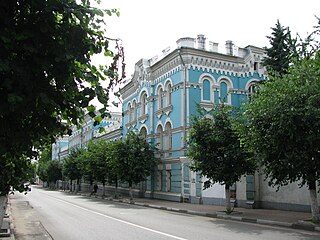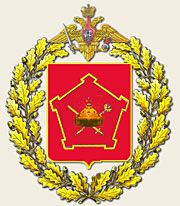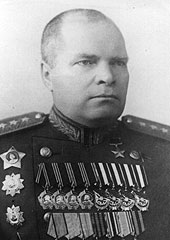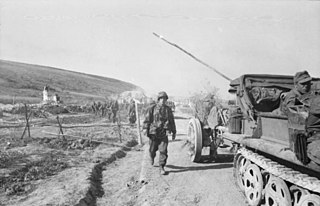
Operation Citadel was a German offensive operation against Soviet forces in the Kursk salient during the Second World War on the Eastern Front that initiated the Battle of Kursk. The deliberate defensive operation that the Soviets implemented to repel the German offensive is referred to as the Kursk Strategic Defensive Operation. The German offensive was countered by two Soviet counter-offensives, Operation Polkovodets Rumyantsev and Operation Kutuzov. For the Germans, the battle was the final strategic offensive that they were able to launch on the Eastern Front. As the Allied invasion of Sicily began, Adolf Hitler was forced to divert troops training in France to meet the Allied threats in the Mediterranean, rather than use them as a strategic reserve for the Eastern Front. Germany's extensive loss of men and tanks ensured that the victorious Soviet Red Army enjoyed the strategic initiative for the remainder of the war.

The Second Battle of Târgu Frumos, part of the First Jassy-Kishinev Offensive, was a military engagement primarily between the Wehrmacht and Red Army forces in May 1944, near Iași, Romania.

The 67th Guards Rifle Division was a Guards infantry division of the Red Army during World War II.

The 5th Shock Army was a Red Army field army of World War II. The army was formed on 9 December 1942 by redesignating the 10th Reserve Army. The army was formed two times prior to this with neither formation lasting more than a month before being redesignated.
The 70th Guards Rifle Division was an infantry division of the Red Army and Soviet Army. It was formed after the Battle of Stalingrad from the 138th Rifle Division in recognition of that division's actions during the battle. The 70th Guards continued a record of distinguished service through the rest of the Great Patriotic War, and continued to serve postwar, as a motor rifle division, until being finally disbanded in 1991.
The 119th Rifle Division was an infantry division of the Red Army, formed three times.

The Battle of Rzhev in the Summer of 1942 was part of a series of battles that lasted 15 months in the center of the Eastern Front. It is known in Soviet history of World War II as the First Rzhev–Sychyovka Offensive Operation, which was defined as spanning from 30 July to 23 August 1942. However, it is widely documented that the fighting continued undiminished into September and did not finally cease until the beginning of October 1942. The Red Army suffered massive casualties for little gain during the fighting, giving the battle a notoriety reflected in its sobriquet: "The Rzhev Meat Grinder".

The 300th Rifle Division began service as a standard Red Army rifle division shortly after the German invasion, and fought in the southwestern part of the Soviet-German front for nearly two years following. It was able to escape the encirclement east of Kiev in September, 1941, and then fought to defend, and later to try to liberate, the city of Kharkov during 1941-42. After falling back under the weight of the German 1942 summer offensive, the division began distinguish itself during Operation Uranus in late 1942, when it helped defeat the German attempt to relieve Sixth Army and later in the pursuit of the defeated Axis forces and the second liberation of Rostov-na-Donu. In recognition of these successes it was raised to Guards status as the 87th Guards Rifle Division. A second 300th Rifle Division was raised a few months later and fought briefly but very successfully against the Japanese in Manchuria in August 1945. The second formation became the 3rd Tank Division in the Far East postwar and was redesignated as the 46th Tank Division in 1957 before disbanding in 1959.
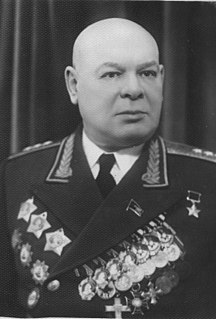
The 304th Rifle Division had its roots in the 109th Mechanized Division, which served before the Great Patriotic War as a mixed armor and infantry formation. Soon after the German invasion it was reorganized as a standard rifle division and renumbered as the 304th. It served in the southwestern part of the Soviet-German front for more than a year and a half, fighting under difficult conditions, including the German summer offensive of 1942. The division did not distinguish itself until Operation Uranus in late 1942 and the subsequent Operation Ring, in which it helped defeat the encircled German Sixth Army. In recognition of these successes, even before the German surrender at Stalingrad, it was raised to Guards status as the 67th Guards Rifle Division. A second 304th was raised six months later, based on a pair of rifle brigades, facing the German 17th Army in the Kuban. After helping to liberate this region the division continued in combat through Ukraine and Poland, winning its own distinctions at Zhitomir and an Order of the Red Banner, before ending the war near Prague.
The 120th Rifle Division was an infantry division of the Red Army, formed three times. Its first formation became the 6th Guards Rifle Division for its actions in the Yelnya Offensive. Its second formation became the 69th Guards Rifle Division for its actions in the Battle of Stalingrad. The division was reformed a third time in late April 1943. It was disbanded "in place" with the Central Group of Forces in the summer of 1945.

The 422nd Rifle Division was formed for the first time as a standard Red Army rifle division late in 1941, after the Soviet winter counteroffensive had begun, but was soon re-designated. A second formation began in March, 1942, again in the far east of Siberia, until July, after which it was moved west to join the reserves of Stalingrad Front in August. It was the highest-numbered rifle division to see active service in the front lines during the Great Patriotic War. Over the course of the next six months, the division distinguished itself in both defensive and offensive fighting and earned its re-designation as the 81st Guards Rifle Division on the first day of March, 1943. The 422nd was never reformed.

The 169th Rifle Division was formed as a standard Red Army rifle division beginning in late August, 1939, as part of the pre-war Soviet military build-up. It saw service in the occupation force in western Ukraine in September. The German invasion found it still in Ukraine, fighting back to the Dniepr until it was nearly destroyed. The partly-rebuilt division fought again at Kharkov, then was pulled back into reserve and sent deep into the Caucasus where it fought south of Stalingrad throughout that battle. Following another major redeployment the division helped in the liberation of Oryol, and the following race to the Dniepr. In 1944 and 1945 it was in 1st and 2nd Belorussian Fronts, participating successfully in the offensives that liberated Belarus, Poland, and conquered eastern Germany. It ended the war on the Elbe River.

The 315th Rifle Division was a standard Red Army rifle division formed for the first time on February 12, 1942 in the Siberian Military District before being sent to the vicinity of Stalingrad, where it was engaged in the futile efforts to break through to the besieged city from the north near Kotluban. After rebuilding, it was part of the southern thrust of Operation Uranus in November, helping to encircle the German 6th Army and also to hold off its would-be rescuers. During 1943 and early 1944 the division advanced through the southern Donbass and into Ukraine, where it was honored for its role in the liberation of Melitopol, before taking part in the liberation of the Crimea in April and May, 1944. The men and women of the 315th ended their war on an anti-climactic note, serving for the last year as part of the garrison of the Crimea. However, the unit, and its successors, continued to serve well into the postwar era.
The 16th Guards Tank Division was a tank division of the Soviet Army and later the Russian Ground Forces.

The 333rd Rifle Division began forming in the North Caucasus Military District in August, 1941, as a standard Red Army rifle division, as part of the massive mobilization of reserve forces very shortly after the German invasion. In 1942 it served in the late winter and early spring fighting near Kharkov, taking a beating both then and during the opening stages of the German summer offensive. Withdrawn into the reserves, the division was rebuilt in time to take part in the Soviet counteroffensive at Stalingrad in November, and played an important role in driving the German forces out of the Caucasus region during the winter. In the autumn of 1943 the division shared credit with the 25th Guards Rifle Division for the liberation of Sinelnikovo in the Dnipropetrovsk Oblast, receiving that place name as an honorific. After battling through Ukraine and into the Balkan states, the 333rd completed its combat path on a relatively quiet note doing garrison duties in the Balkans.

The 61st Cavalry Division was a cavalry division of the Red Army that served in the first years of the Great Patriotic War. It was formed in September – October, 1941, and saw its first actions to the south of Stalingrad during the German siege of that city in the autumn of 1942. When the Soviet counteroffensive, Operation Uranus, began in November the 61st formed a significant part of the mobile forces of its 51st Army. After the positions of Romanian 4th Army were broken through the division took part in the exploitation to the southwest, but became overextended and vulnerable to the mobile German reinforcements arriving to attempt a breakthrough to their Sixth Army. The 61st suffered such severe losses that it had to be withdrawn to the reserves in December, and was later disbanded.

The 343rd Rifle Division was first formed in late August, 1941, as a standard Red Army rifle division, at Stavropol, in the Caucasus region. Its first major operation was in the liberation of Rostov in December, 1941. Following this, it was nearly caught up in the debacle near Kharkov in May, 1942, but managed to evade the German spearheads during Operation Blue to join the forces defending the Stalingrad region during the summer and fall. Following the German surrender at Stalingrad, on May 4, 1943, it was re-designated as the 97th Guards Rifle Division. Over a year later, a new 343rd Rifle Division was formed, based on the personnel and equipment of a Fortified Region, just after the start of Operation Bagration, the destruction of German Army Group Center. This new division went on to distinguish itself by helping to liberate the Polish city of Białystok, and ended the war in East Prussia, near Königsberg.

The 346th Rifle Division began forming in late August, 1941, as a standard Red Army rifle division, in the Volga Military District. It was assigned to the 61st Army while both it and its Army continued to form up before moving to the front lines in December to take part in the winter counteroffensive south of Moscow. In September, 1942, it became part of the 5th Tank Army, and joined the offensive that encircled German Sixth Army at Stalingrad during Operation Uranus. During 1943 and early 1944 it continued to serve in the southern part of the front, taking part in the liberation of Crimea, before being transferred to the Baltic States region, serving in Latvia and Lithuania until February, 1945, when it was once again reassigned, this time to be part of the follow-on forces in the conquest of eastern Germany. The division ended the war with a distinguished service record, but was disbanded shortly after the German surrender.

The 381st Rifle Division was raised in 1941 as an infantry division of the Red Army, and served for the duration of the Great Patriotic War in that role. It began forming in August, 1941 in the Urals Military District. It first served in the bitter fighting around the Rzhev salient, deep in the German rear in the 39th Army and came close to being completely destroyed in July, 1942. The division's survivors were moved north well away from the front for a major rebuilding. It returned to the front in October, joining the 3rd Shock Army for the battle and siege of Velikiye Luki. The division remained in this general area in western Russia until March, 1944, when it was moved to the Reserve of the Supreme High Command and then to 21st Army north of Leningrad in April. It served in the offensive that drove Finland out of the war from June to September, winning a battle honor and the Order of the Red Banner in the process, before being transferred back to the Soviet-German front in October. As part of the 2nd Shock Army of 2nd Belorussian Front the 381st advanced across Poland and Pomerania during the winter of 1945, then joined its Front's advance across the Oder River into north-central Germany in late April, ending the war on the Baltic coast. In the summer of that year the division was disbanded.

The 387th Rifle Division was raised in 1941 as an infantry division of the Red Army, and served for the duration of the Great Patriotic War in that role. It began forming on September 1, 1941 in the Central Asia Military District. It first served in the winter counteroffensive south of Moscow, then spent the spring and summer of 1942 on the relatively quiet fronts southwest of the capital in the area of Kaluga and Tula. In September it was withdrawn to the Reserve of the Supreme High Command where it joined the 1st Reserve Army. This became the 2nd Guards Army and the division fought south of Stalingrad against Army Group Don during the German attempt to relieve their encircled 6th Army in December. During January and into February, 1943, 2nd Guards advanced on both sides of the lower Don River towards Rostov in a race to prevent Army Group A from escaping being trapped in the Caucasus region. The division was now part of Southern Front and it would remain in that Front until May, 1944. During the summer advance through the Donbass and southern Ukraine the 387th served under several different army commands before returning to 2nd Guards for the Crimean Offensive in April, 1944, during which it won a battle honor. After the Crimea was cleared the division remained there as part of the Separate Coastal Army until it went back to the Reserve in March, 1945. It then was assigned to the 2nd Ukrainian Front as a separate rifle division, and spent the last weeks of the war in Hungary and Austria. It continued to serve briefly into the postwar period.






